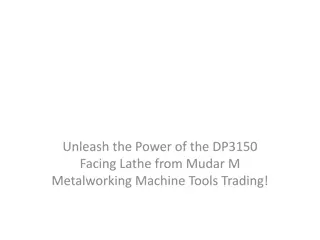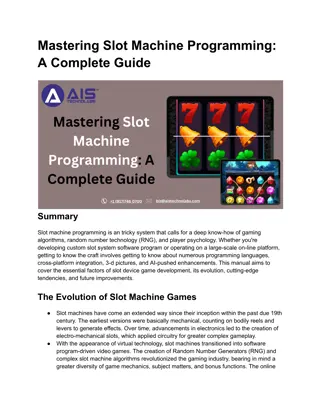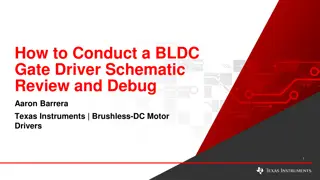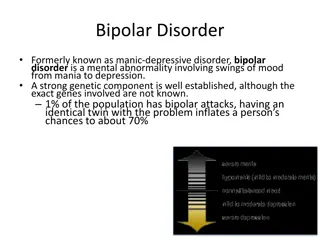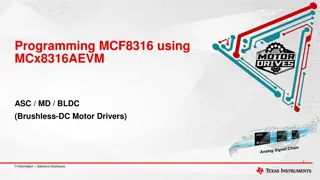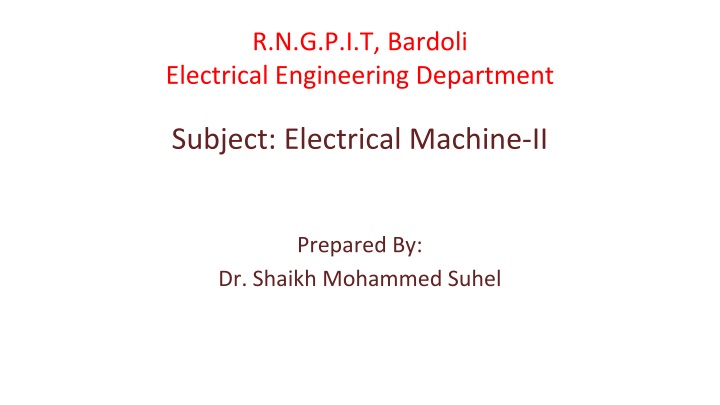
Electrical Machine-II Lecture on Bipolar BLDC Motor by Dr. Shaikh Mohammed Suhel
Dive into the theory of Bipolar BLDC Motors in this insightful lecture by Dr. Shaikh Mohammed Suhel from R.N.G.P.I.T, Bardoli. Understand the principles, configurations, and working mechanisms of Bipolar BLDC drives and motors. Explore the innovative concepts that enhance torque production and efficiency. Watch the accompanying YouTube video for a more in-depth understanding of this advanced electrical engineering topic.
Uploaded on | 0 Views
Download Presentation

Please find below an Image/Link to download the presentation.
The content on the website is provided AS IS for your information and personal use only. It may not be sold, licensed, or shared on other websites without obtaining consent from the author. If you encounter any issues during the download, it is possible that the publisher has removed the file from their server.
You are allowed to download the files provided on this website for personal or commercial use, subject to the condition that they are used lawfully. All files are the property of their respective owners.
The content on the website is provided AS IS for your information and personal use only. It may not be sold, licensed, or shared on other websites without obtaining consent from the author.
E N D
Presentation Transcript
R.N.G.P.I.T, Bardoli Electrical Engineering Department Subject: Electrical Machine-II Prepared By: Dr. Shaikh Mohammed Suhel
Prepared By: Name: Dr. Shaikh Mohammed Suhel (Assistant Professor RNGPIT, Surat) Former Assistant Professor in SCET, SNPIT&RC, VIT Qualification: PhD (Power- Electronics & Drives, NIT, Surat), M.Tech (Industrial Electronics, NIT- Surat), Gate, B.E. (Electrical Engineering., VNSGU- Surat). Experience: 13 Years.
Subject: Electrical Machine-II This Lecture contains Theory of Bipolar BLDC Machine YouTube Video : https://youtu.be/TwCmwBWyC5A
Bipolar BLDC Drives: >Unipolar Drives: Current in every windings in one direction >At any time only one winding is excited. >So, motor is underutilized >Bipolar configuration to enhance torque production w1 S S S w2 w3
Bipolar BLDC Motor: Principle C N >All winding have N numbers of turns N I A NI > Winding carrying I amount of current, mmf=NI N B
Bipolar BLDC Motor: Principle C N >All winding have N numbers of turns N I A NI >Winding current, and hence mmf=NI carrying amount of I N B >Remaining winding carrying I/2 of current, and hence mmf=NI/2 >Resultant mmf= NI+(NI/2)Cos60+(NI/2)Cos60= 3/2 NI and hence torque 1.5pu NI 600 3/2NI
Bipolar BLDC Motor: Principle I >Inverter has six switches and allow the bidirectional current flow. A B C I/2 I/2 I/2 >A, B, and C terminals of Inverter are connected to A, B, and C terminal of three phase stator Winding of BLDC machine. >Inverter operates in 120 Mode >If I amount of current entering in A winding, I/2 amount of current leaving from the other two windings or vice versa C I/2 I I A I/2 B I/2
>six optical encoders that have six photo transistor placed with 60 degree apart. wA Transparent >The rotor is also attached with a disc which has half opaque region that is non-transparent and half of transparent and allow the light to pass through. the region is wc wB Non-transparent
LOW >At any given time three photo transistor are turning ON. HIGH wA >After every 60 degree rotation sequence is changing. >PT1, PT2, PT3, PT4, PT5, PT6 1 1 1 0 1 1 0 0 1 0 0 0 1 0 0 1 1 0 PT3 0 0 0 PT2 1 1 1 0 0 0 1 1 1 0 0 0 1 1 1 wc wB
wA A B T1,T4 C T3,T6 wc wB T5,T2
T5,T2 A B C N 900 PT2 PT3 A PT1 S T1,T4 N NI S N PT4 I PT6 S PT5 -I/2 -I/2 B T3,T6
-I/2 PT2 PT3 A PT1 I I PT4 PT6 PT5 S N -I/2 -I/2 -I/2 B >PT1, PT2, PT3, PT4, PT5, PT6 T6 T1 T2 T3 T4 T5
-I A C B PT2 I/2 PT3 A PT1 S N PT4 PT6 I/2 PT5 I/2 I/2 B I >PT1, PT2, PT3, PT4, PT5, PT6 T6 T1 T2 T3 T4 T5
-I/2 C A B PT2 -I/2 PT3 A PT1 PT4 PT6 PT5 I I B I/2 I/2 >PT1, PT2, PT3, PT4, PT5, PT6 T6 T1 T2 T3 T4 T5
>PT1, PT2, PT3, PT4, PT5, PT6 1 1 1 0 1 1 0 0 1 0 0 0 1 0 0 1 1 0 0 0 0 1 1 1 0 0 0 1 1 1 0 0 0 1 1 1 wA N S PT3 PT2 >state sixty degree interval. changes after every wc wB
>PT1, PT2, PT3, PT4, PT5, PT6 1 1 1 0 1 1 0 0 1 0 0 0 1 0 0 1 1 0 0 0 0 1 1 1 0 0 0 1 1 1 0 0 0 1 1 1 wA N S PT3 PT2 >state sixty degree interval. changes after every wc wB

